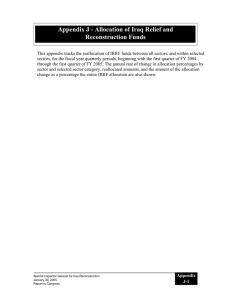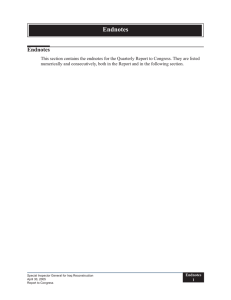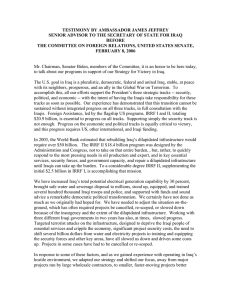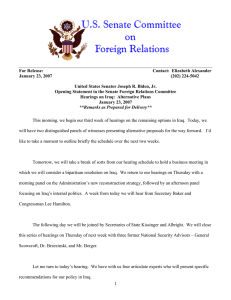about 70%. This collapse has had severe consequences for Iraq
advertisement
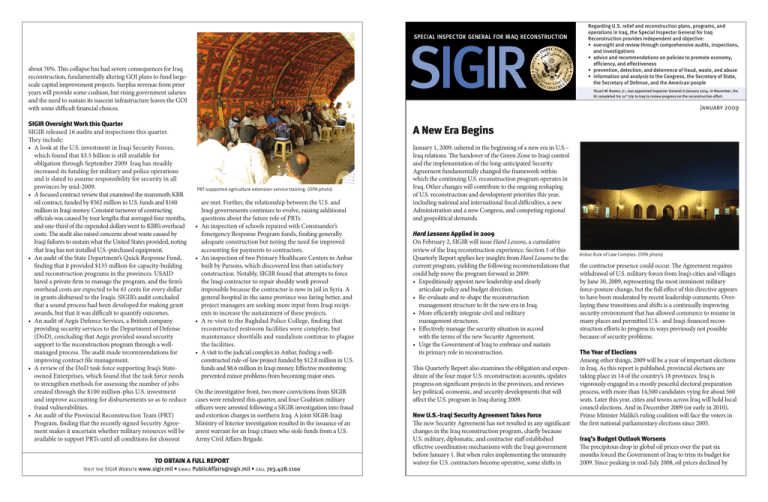
Regarding U.S. relief and reconstruction plans, programs, and operations in Iraq, the Special Inspector General for Iraq Reconstruction provides independent and objective: • oversight and review through comprehensive audits, inspections, and investigations • advice and recommendations on policies to promote economy, efficiency, and effectiveness • prevention, detection, and deterrence of fraud, waste, and abuse • information and analysis to the Congress, the Secretary of State, the Secretary of Defense, and the American people about 70%. This collapse has had severe consequences for Iraq reconstruction, fundamentally altering GOI plans to fund largescale capital improvement projects. Surplus revenue from prior years will provide some cushion, but rising government salaries and the need to sustain its nascent infrastructure leaves the GOI with some difficult financial choices. SIGIR Oversight Work this Quarter SIGIR released 16 audits and inspections this quarter. They include: • A look at the U.S. investment in Iraqi Security Forces, which found that $3.5 billion is still available for obligation through September 2009. Iraq has steadily increased its funding for military and police operations and is slated to assume responsibility for security in all provinces by mid-2009. • A focused contract review that examined the mammoth KBR oil contract, funded by $562 million in U.S. funds and $160 million in Iraqi money. Constant turnover of contracting officials was caused by tour lengths that averaged four months, and one-third of the expended dollars went to KBR’s overhead costs. The audit also raised concerns about waste caused by Iraqi failures to sustain what the United States provided, noting that Iraq has not installed U.S.-purchased equipment. • An audit of the State Department’s Quick Response Fund, finding that it provided $135 million for capacity-building and reconstruction programs in the provinces. USAID hired a private firm to manage the program, and the firm’s overhead costs are expected to be 61 cents for every dollar in grants disbursed to the Iraqis. SIGIR’s audit concluded that a sound process had been developed for making grant awards, but that it was difficult to quantify outcomes. • An audit of Aegis Defence Services, a British company providing security services to the Department of Defense (DoD), concluding that Aegis provided sound security support to the reconstruction program through a wellmanaged process. The audit made recommendations for improving contract file management. • A review of the DoD task force supporting Iraq’s Stateowned Enterprises, which found that the task force needs to strengthen methods for assessing the number of jobs created through the $100 million-plus U.S. investment and improve accounting for disbursements so as to reduce fraud vulnerabilities. • An audit of the Provincial Reconstruction Team (PRT) Program, finding that the recently signed Security Agreement makes it uncertain whether military resources will be available to support PRTs until all conditions for closeout Stuart W. Bowen, Jr., was appointed Inspector General in January 2004. In November, the IG completed his 21st trip to Iraq to review progress on the reconstruction effort. January 2009 A New Era Begins PRT-supported agriculture extension service training. (OPA photo) are met. Further, the relationship between the U.S. and Iraqi governments continues to evolve, raising additional questions about the future role of PRTs. • An inspection of schools repaired with Commander’s Emergency Response Program funds, finding generally adequate construction but noting the need for improved accounting for payments to contractors. • An inspection of two Primary Healthcare Centers in Anbar built by Parsons, which discovered less than satisfactory construction. Notably, SIGIR found that attempts to force the Iraqi contractor to repair shoddy work proved impossible because the contractor is now in jail in Syria. A general hospital in the same province was faring better, and project managers are seeking more input from Iraqi recipients to increase the sustainment of these projects. • A re-visit to the Baghdad Police College, finding that reconstructed restroom facilities were complete, but maintenance shortfalls and vandalism continue to plague the facilities. • A visit to the judicial complex in Anbar, finding a wellconstructed rule-of-law project funded by $12.8 million in U.S. funds and $8.6 million in Iraqi money. Effective monitoring prevented minor problems from becoming major ones. On the investigative front, two more convictions from SIGIR cases were rendered this quarter, and four Coalition military officers were arrested following a SIGIR investigation into fraud and extortion charges in northern Iraq. A joint SIGIR-Iraqi Ministry of Interior investigation resulted in the issuance of an arrest warrant for an Iraqi citizen who stole funds from a U.S. Army Civil Affairs Brigade. TO OBTAIN A FULL REPORT Visit the SIGIR Website www.sigir.mil • email PublicAffairs@sigir.mil • call 703.428.1100 January 1, 2009, ushered in the beginning of a new era in U.S.– Iraq relations. The handover of the Green Zone to Iraqi control and the implementation of the long-anticipated Security Agreement fundamentally changed the framework within which the continuing U.S. reconstruction program operates in Iraq. Other changes will contribute to the ongoing reshaping of U.S. reconstruction and development priorities this year, including national and international fiscal difficulties, a new Administration and a new Congress, and competing regional and geopolitical demands. Hard Lessons Applied in 2009 On February 2, SIGIR will issue Hard Lessons, a cumulative review of the Iraq reconstruction experience. Section 1 of this Quarterly Report applies key insights from Hard Lessons to the current program, yielding the following recommendations that could help move the program forward in 2009: • Expeditiously appoint new leadership and clearly articulate policy and budget direction. • Re-evaluate and re-shape the reconstruction management structure to fit the new era in Iraq. • More efficiently integrate civil and military management structures. • Effectively manage the security situation in accord with the terms of the new Security Agreement. • Urge the Government of Iraq to embrace and sustain its primary role in reconstruction. This Quarterly Report also examines the obligation and expenditure of the four major U.S. reconstruction accounts, updates progress on significant projects in the provinces, and reviews key political, economic, and security developments that will affect the U.S. program in Iraq during 2009. New U.S.-Iraqi Security Agreement Takes Force The new Security Agreement has not resulted in any significant changes in the Iraq reconstruction program, chiefly because U.S. military, diplomatic, and contractor staff established effective coordination mechanisms with the Iraqi government before January 1. But when rules implementing the immunity waiver for U.S. contractors become operative, some shifts in Anbar Rule of Law Complex. (OPA photo) the contractor presence could occur. The Agreement requires withdrawal of U.S. military forces from Iraq’s cities and villages by June 30, 2009, representing the most imminent military force-posture change, but the full effect of this directive appears to have been moderated by recent leadership comments. Overlaying these transitions and shifts is a continually improving security environment that has allowed commerce to resume in many places and permitted U.S.- and Iraqi-financed reconstruction efforts to progress in ways previously not possible because of security problems. The Year of Elections Among other things, 2009 will be a year of important elections in Iraq. As this report is published, provincial elections are taking place in 14 of the country’s 18 provinces. Iraq is vigorously engaged in a mostly peaceful electoral preparation process, with more than 14,500 candidates vying for about 560 seats. Later this year, cities and towns across Iraq will hold local council elections. And in December 2009 (or early in 2010), Prime Minister Maliki’s ruling coalition will face the voters in the first national parliamentary elections since 2005. Iraq’s Budget Outlook Worsens The precipitous drop in global oil prices over the past six months forced the Government of Iraq to trim its budget for 2009. Since peaking in mid-July 2008, oil prices declined by SIGIR Special Inspector General for Iraq Reconstruction Major Ongoing GRD Infrastructure Projects d Two 132-kV substations constructed in Sadr City (IRRF 2) Quarterly Report and Semiannual Report to The United States Congress January 2009 Status of U.S. Funds a Appropriated $51.01 obligated ISFF $3.37 1% 4% 88% Qudas Power Plant 87% $169 M 8% 5% obligated ESF $0.33 2006 93% A power plant with 10 generators for overall feasible capacity of 738 MW, which can serve 638,000 homes (approx. 4 million people) (IRRF 2) 2009 Baghdad Ninewa Diyala Salah Al-Din Tameem complete State-of-the-art pediatric oncology hospital (Various) Iraq’s 2008 Oil Revenue and Price per Barrel 2008 11% of population 40% of population 56% of population 100% of population (projection) Basrah Children’s Hospital CERP $0.20 2007 Muthanna Qadissiya Missan Thi-Qar Anbar Kerbala Babylon Erbil Najaf Basrah Wassit Sulaymaniyah Dahuk complete $3.90 Billion Change Since Last Quarter Obligated $41.42 Expended $36.58 $48 M Unobligated Major U.S. Funds b $ Billions Timeline of Provincial Iraqi Control e Farabi and Jamila 132-kV Substation Attacks f 6,000 c $ Billions $12 Eastern Euphrates Drain $9 $90 Oil Revenue $ Billions $6 $60 $3 $0 Will serve 1.5 million hectares of farmland from Baghdad through southern Iraq (IRRF 2) $120 Kirkuk Crude Oil Price Dollars per Barrel $38 M obligated $30 J F M A M J J A S O N D $164 M est. cost 4,000 2,000 Nassriya Drainage Pump Station 63% complete $0 % not available $20 M obligated Will provide agricultural runoff drainage for 1.5 million hectares of irrigated land in southern Iraq and improve the Euphrates River water 80% quality (IRRF 2) complete 0 2004 2005 2006 2007 2008 Total Attacks Baghdad Attacks Ninewa Attacks Selected Comparisons of Iraq’s Provinces Population U.S. Funding per Capita CERP Project Costs l I-CERP Projects m Provincial $ Amount of Budget % of Awards to Iraqi Expended First Vendors vs. Allocated o ($ millions) p Infrastructure % of Households in the Poorest Income Quintile q Avg. Daily Electricity Load Served for Quarter (MWh) r Governance Estimated Avg. Daily Demand for Quarter (MWh) s % of People with Access to Water t Community Value of CAP Action Program Projects (CAP) Projects u ($ millions) v Security Total PRDC Budgeted (FY 06 Supplemental & FY 07 Supplemental) ($ millions) w % of PRDC Budgeted Awarded x Total Attacks Total Attacks 7/1/2008– 9/30/2008 y 10/1/2008– 12/31/2008 z Kurdistan 4,621,600 872,278 $132.34 $14.20 $22.35 $21.52 n/a n/a n/a $9.45 19% 14,627 17,426 40% 40 $6.81 $81.14 89% 6 3 May-07 Ninewa 2,473,700 146,055 $180.35 $154.67 $12.71 $78.45 41 $356.67 7% $16.90 31% 10,587 15,972 71% 65 $3.24 $27.43 42% 924 511 Mar-09 839,100 51,135 $770.69 $134.42 $138.04 $201.88 53 $143.33 54% $54.03 31% 5,094 6,162 98% 64 $3.27 $27.10 65% 245 184 Jan-09 Salah Al-Din 1,077,800 65,810 $391.64 $110.59 $110.54 $198.63 148 $146.67 49% $239.05 14% 5,459 7,186 71% 169 $4.37 $24.30 78% 486 308 Jan-09 Anbar 1,280,000 85,134 $390.81 $631.73 $82.69 $331.74 56 $183.33 69% $123.19 24% 4,589 6,206 84% 115 $3.93 $52.28 62% 209 162 Sep-08 Diyala 1,373,900 191,491 $337.37 $190.55 $13.21 $144.81 110 $168.00 18% $36.43 18% 3,623 4,362 54% 75 $3.36 $24.36 76% 533 251 Feb-09 Baghdad 6,386,100 573,301 $492.13 $259.67 $129.63 $167.56 281 $883.33 12% $524.68 5% 31,714 48,420 89% 1,179 $38.41 $147.53 67% 867 713 May-09 Wassit ESF Project Costs k Economy Population g Tameem ISFF Project Costs j 2008 Provincial Budget Allocation ($ millions) n Internally Displaced Persons h Province IRRF Project Costs i Iraqi Funding Provincial Iraqi Control aa 941,800 87,637 $323.03 $66.34 $30.96 $67.97 14 $134.67 50% $35.42 20% 2,724 5,655 89% 89 $5.31 $27.92 91% 8 9 Oct-08 1,444,400 86,047 $134.78 $15.56 $22.66 $118.07 50 $200.67 58% $19.13 28% 4,039 7,915 97% 124 $10.85 $26.85 62% 54 62 Oct-08 Qadissiya 866,700 32,110 $159.28 $41.95 $14.86 $93.94 30 $133.33 25% $5.88 37% 3,077 4,711 76% 67 $7.57 $24.63 74% 7 9 Jul-08 Kerbala 756,000 183,617 $125.28 $1.11 $26.93 $67.37 0 $113.33 33% $3.93 36% 2,883 5,092 71% 77 $9.11 $23.31 72% 4 0 Oct-07 Najaf 946,300 81,674 $189.94 $30.57 $20.99 $44.40 0 $143.33 95% $0.58 13% 3,594 6,973 83% 80 $8.01 $25.72 33% 1 2 Dec-06 Muthanna 536,300 23,497 $479.73 $4.62 $25.78 $46.68 0 $83.33 36% $1.04 28% 2,532 3,770 65% 76 $3.22 $24.95 50% 1 1 Jul-06 1,427,200 72,779 $520.26 $47.90 $13.93 $30.30 11 $216.67 38% $27.74 27% 5,404 7,536 94% 87 $8.13 $25.80 83% 21 7 Sep-06 Missan 743,400 159,749 $234.66 $52.51 $47.85 $38.82 3 $120.00 79% $0.07 16% 2,566 5,090 91% 81 $6.23 $25.94 65% 43 39 Apr-07 Basrah 1,761,000 130,177 $882.67 $70.39 $54.39 $145.05 17 $306.67 37% $213.06 11% 12,032 17,148 98% 130 $8.66 $66.95 63% 26 11 Dec-07 Babylon Thi-Qar For the sources of information used to create this insert (notes a-aa), please see the last endnote in this Quarterly Report. p r o f e ssi o na l is m p r o d u c t i v i t y p e r s e v e r anc e www.sigir.mil • email: PublicAffairs@sigir.mil • (703) 428-1100
